Topics
Category
Era
Minnesota Building, St. Paul
Built in 1929 at Forty-Sixth East Fourth Street, the Minnesota Building represents a turning point in the economic history of downtown St. Paul and the architectural history of the entire Twin Cities area.
In 1922 business and government leaders in St. Paul met to discuss the development of the city. Their main concern was defining a downtown and, within it, a business district. For decades business had been divided between Lowertown, along the river, and the office buildings north of it. Some argued for a broad geographic definition of downtown. They defined its borders as the Mississippi River to the south, the Summit neighborhood to the west, and Dayton's Bluff to the east.
A more focused definition won in the end. The leaders decided to center their attention on a new business district. The district became known as the "business loop." The loop was encompassed by modern-day Kellogg Boulevard, Wacouta Street, Twelfth Street, and Main Street (now mostly eliminated). The district included existing business buildings but new construction was desired. Except for the Hotel Lowry, no multistory buildings were erected in downtown St. Paul from 1919 to 1929.
In 1928 developers purchased the Minnesota Club building and razed it. They commissioned St. Paul native and architect Charles Hausler to design a new office building. Hausler had apprenticed with Louis Sullivan in Chicago, then served as St. Paul's city architect from 1914 to 1923.
Construction of the Minnesota Building began in June of 1929 and progressed smoothly. It was dedicated in October of 1929, having cost $950,000 to build. On November 12, 450 people attended an open house celebrating its completion. Its creation ended a decade-long drought of construction in downtown St. Paul. The building was the first in a new series to be built in the "business loop." It housed upscale offices and provided a prestigious address for companies.
Within the Twin Cities, the Minnesota Building was an architectural first and a sign of things to come. All previous twentieth-century construction had been in the traditional Beaux-Arts, classical, or neoclassical styles. The Minnesota Building was the first art-deco-style and modern building in the Twin Cities. It helped reinvent the business architecture of the Twin Cities. Several art-deco buildings followed it. Examples of local art-deco structures constructed shortly after the Minnesota Building include the St. Paul City Hall and Ramsey County Courthouse, the First National Bank Building, the Qwest Building, the Minneapolis U.S. Post Office, Foshay Tower, and Rand Tower.
The exterior of the building features traditional art-deco styling. It emphasizes geometric forms and symmetry. The pedestrian level has tile and terracotta stone work. The main entrances are flanked by large display windows. Over the main entrance is a stone medallion of the state of Minnesota guarded by two stylized eagles. The secondary facades display the words "MINNESOTA BLDG" between the twelfth and thirteenth floors. The interior has bright terrazzo floors, marble walls, geometric plaster work, bronze lamps, and hardware.
Throughout the twentieth century the Minnesota Building served St. Paul as an office building and business center. At the beginning of the twenty-first century the Twin Cities office market declined. Businesses consolidated, or left the cities for more modern accommodations in the suburbs. By 2006 the building was vacant. Through public investment it was renovated into a housing complex. Several government-subsidized apartments were set aside for chronically homeless people. On February 24, 2011 the Minnesota Building was rededicated by St. Paul Mayor Chris Coleman and St. Paul developers. It provided affordable housing for working class St. Paul residents along with business space on the ground level.
Aside from the early addition of the thirteenth floor, the structure is mostly unaltered. The exterior and public spaces of the interior are well preserved. As part of the building's redevelopment efforts were made to protect it. In 2009 the Minnesota Building was added to the National Register of Historic Places.
Bibliography
Minnesota Building. National Register of Historic Places nomination file, reference number 09000408.
Editor's note: This nomination file was the main source used in the writing of this article.
Related Resources
Primary
"Baker Plan of Buildings on Present Court House Site." St. Paul Pioneer Press, September 15, 1929.
"Bird's Eye View of the Loop." St. Paul Pioneer Press, October 27, 1929.
Charles A. Hausler Papers, 1912–1954
Manuscript Collection, University of Minnesota Northwest Architectural Archives, Minneapolis
http://special.lib.umn.edu/findaid/xml/naa006.xml
Description: Collection contains watercolor renderings, sketches, and photographs from Charles Hausler's private practice, documenting more than one hundred buildings, including civic and commercial structures, churches, residences, banks, hospitals, and schools.
"Marble Facing of New Minnesota Building Recalls Pre-Historic Age." St. Paul Pioneer Press, October 13, 1929.
Melo, Frederick. "Downtown St. Paul gets new housing-at a historic site." St. Paul Pioneer Press, February 25, 2011.
"Minnesota Building to Have Open House." St. Paul Pioneer Press, October 27, 1929.
"Work Progressing on 3rd Street Improvements To Cost 4 Million." St. Paul Pioneer Press, September 22, 1929.
"3 Progress Pictures of the New Minnesota Building." St. Paul Pioneer Press, September 1, 1929.
"65,000 Pledged for New Building, Women's City Club Heard at Luncheon." St. Paul Pioneer Press, November 7, 1929.
Secondary
Duncan, Alistair. American Art Deco. London: Thames and Hudson, 1986.
——— , ed. Encyclopedia of Art Deco. New York: Quatro Publishing, 1988.
Gebhard, David, and Tom Martinson. A Guide to the Architecture of Minnesota. Minneapolis: University of Minnesota Press, 1977.
Hess, Jeffery, and Paul Clifford Larson. St. Paul's Architecture. Minneapolis: University of Minnesota Press, 2006.
Jacob, Bernard, and Carol Morphew. Pocket Architecture. Revised edition. [Minneapolis]: N.p., 1987.
Millett, Larry. AIA Guide to Downtown St. Paul. St. Paul: Minnesota Historical Society Press, 2010.
Wingerd, Mary Lethert. Claiming the City: Politics, Faith, and the Power of Place in St. Paul. Ithaca, NY: Cornell University Press, 2001.
Zellie, Carol. St. Paul Historic Context Study: Downtown St. Paul, 1849–1975. [St. Paul]: Saint Paul Heritage Commission, 2001.
Related Images
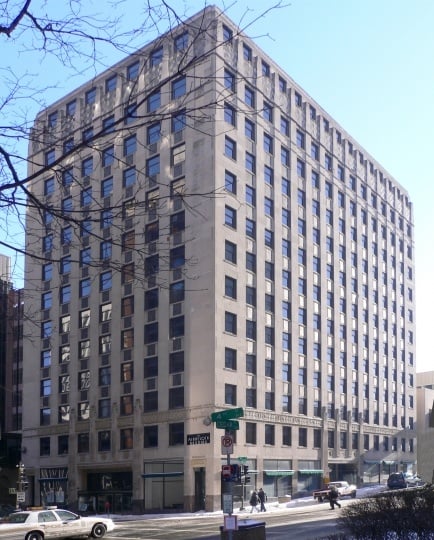
The Minnesota Building
All rights reserved
Holding Location
Articles
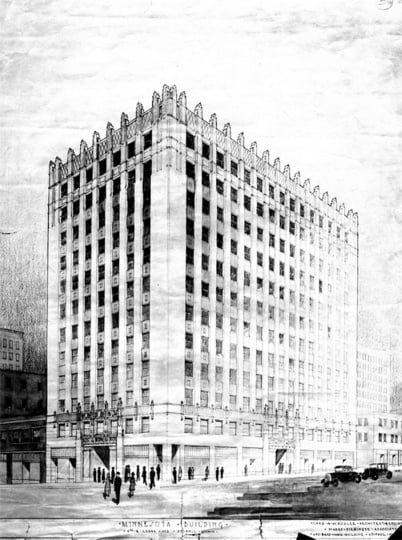
Drawing of Minnesota Building
Holding Location
Articles
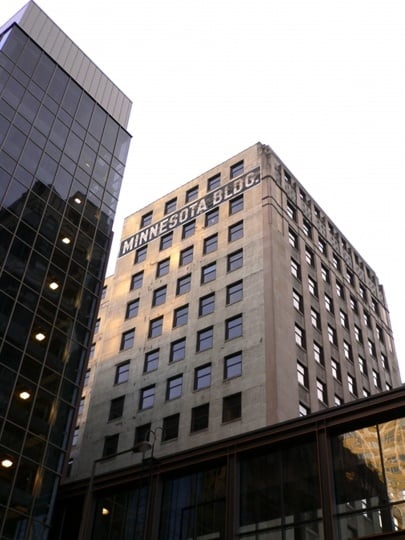
North façade of the Minnesota Building
The north façade of the Minnesota Building showing the words "MINNESOTA BDLG" between the twelfth and thirteenth floors, 2009. Photograph by Thomas R. Zahn.
All rights reserved
Holding Location
Articles
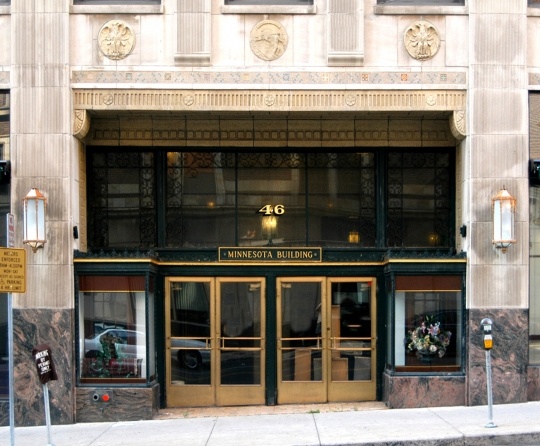
Main entrance of the Minnesota Building
All rights reserved
Holding Location
Articles
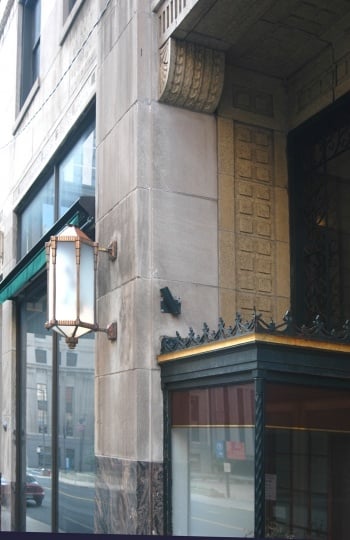
Minnesota Building exterior detailing
All rights reserved
Holding Location
Articles
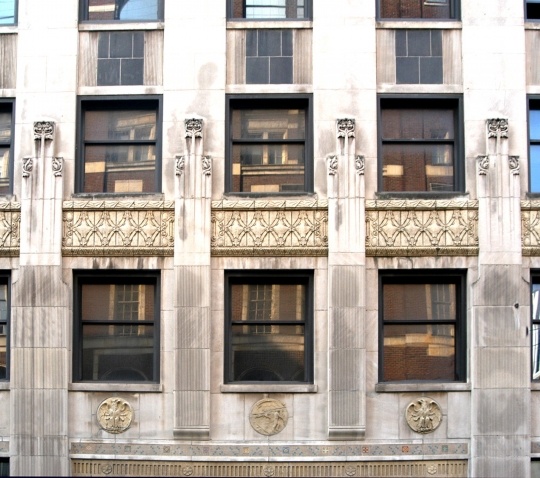
West façade exterior of the Minnesota Building
All rights reserved
Holding Location
Articles
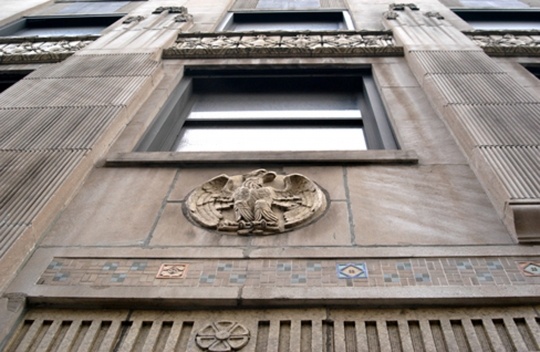
Eagle medallion and tile work, Minnesota Building
All rights reserved
Holding Location
Articles
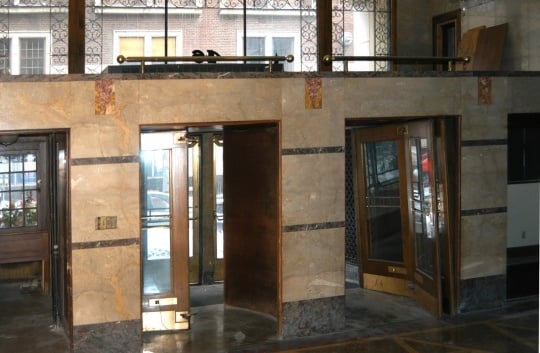
Interior entrance of the Minnesota Building
All rights reserved
Holding Location
Articles
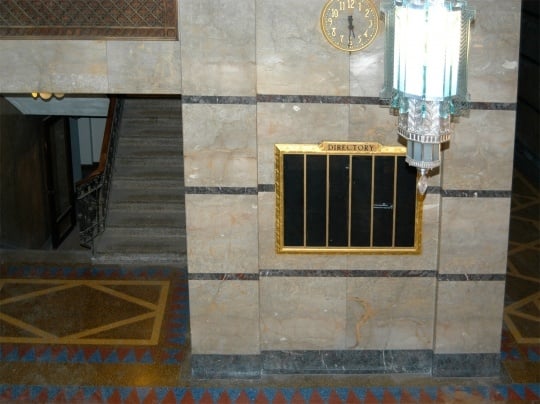
Interior floor and marble work, Minnesota Building
All rights reserved
Holding Location
Articles
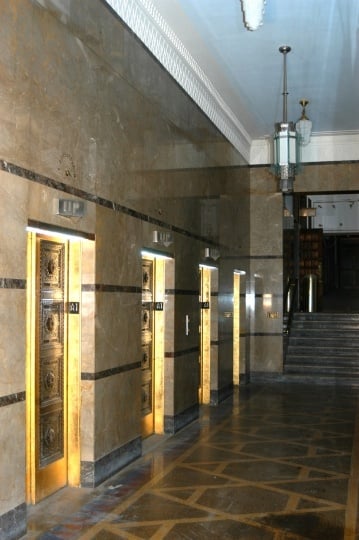
Art Deco-styled elevator bay, Minnesota Building
All rights reserved
Holding Location
Articles
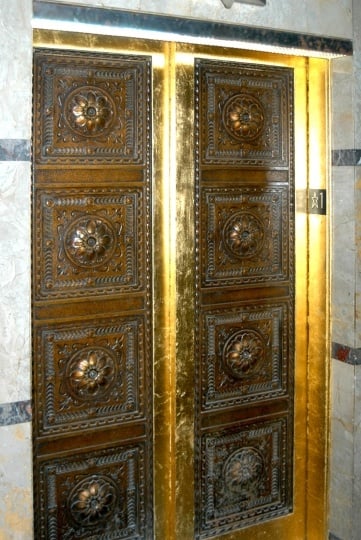
Elevator doors, Minnesota Building
All rights reserved
Holding Location
Articles
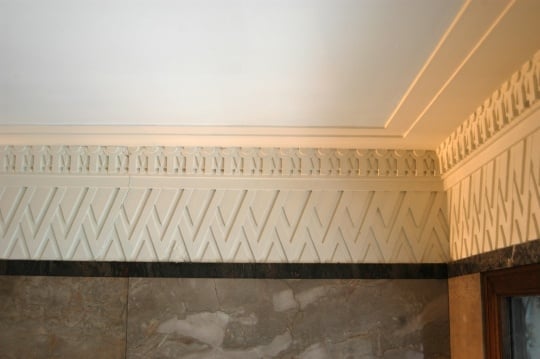
Zig-zag plastered crown molding, Minnesota Building
All rights reserved
Holding Location
Articles
Related Articles
Turning Point
In October of 1929 the Minnesota Building is dedicated, ushering in a new era of architectural design in the Twin Cities.
Chronology
1922
1927
1928
1929
2006
2009
2011
Bibliography
Minnesota Building. National Register of Historic Places nomination file, reference number 09000408.
Editor's note: This nomination file was the main source used in the writing of this article.
Related Resources
Primary
"Baker Plan of Buildings on Present Court House Site." St. Paul Pioneer Press, September 15, 1929.
"Bird's Eye View of the Loop." St. Paul Pioneer Press, October 27, 1929.
Charles A. Hausler Papers, 1912–1954
Manuscript Collection, University of Minnesota Northwest Architectural Archives, Minneapolis
http://special.lib.umn.edu/findaid/xml/naa006.xml
Description: Collection contains watercolor renderings, sketches, and photographs from Charles Hausler's private practice, documenting more than one hundred buildings, including civic and commercial structures, churches, residences, banks, hospitals, and schools.
"Marble Facing of New Minnesota Building Recalls Pre-Historic Age." St. Paul Pioneer Press, October 13, 1929.
Melo, Frederick. "Downtown St. Paul gets new housing-at a historic site." St. Paul Pioneer Press, February 25, 2011.
"Minnesota Building to Have Open House." St. Paul Pioneer Press, October 27, 1929.
"Work Progressing on 3rd Street Improvements To Cost 4 Million." St. Paul Pioneer Press, September 22, 1929.
"3 Progress Pictures of the New Minnesota Building." St. Paul Pioneer Press, September 1, 1929.
"65,000 Pledged for New Building, Women's City Club Heard at Luncheon." St. Paul Pioneer Press, November 7, 1929.
Secondary
Duncan, Alistair. American Art Deco. London: Thames and Hudson, 1986.
——— , ed. Encyclopedia of Art Deco. New York: Quatro Publishing, 1988.
Gebhard, David, and Tom Martinson. A Guide to the Architecture of Minnesota. Minneapolis: University of Minnesota Press, 1977.
Hess, Jeffery, and Paul Clifford Larson. St. Paul's Architecture. Minneapolis: University of Minnesota Press, 2006.
Jacob, Bernard, and Carol Morphew. Pocket Architecture. Revised edition. [Minneapolis]: N.p., 1987.
Millett, Larry. AIA Guide to Downtown St. Paul. St. Paul: Minnesota Historical Society Press, 2010.
Wingerd, Mary Lethert. Claiming the City: Politics, Faith, and the Power of Place in St. Paul. Ithaca, NY: Cornell University Press, 2001.
Zellie, Carol. St. Paul Historic Context Study: Downtown St. Paul, 1849–1975. [St. Paul]: Saint Paul Heritage Commission, 2001.













